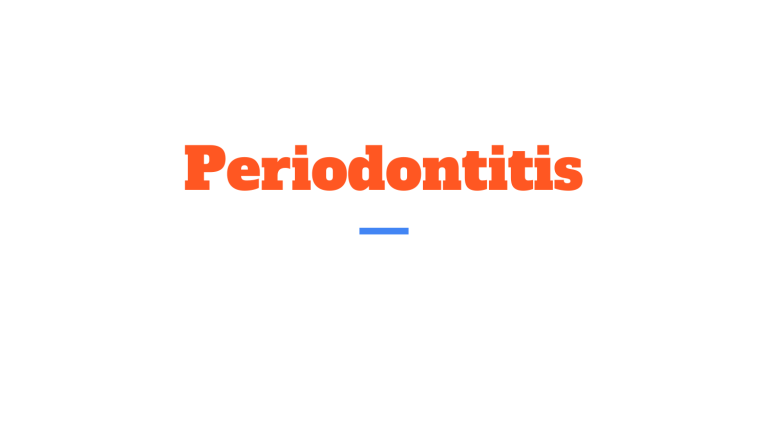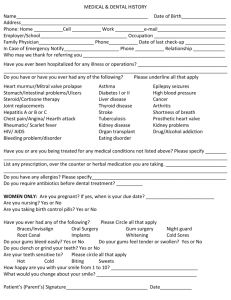
Periodontitis is a serious gum infection that damages the soft tissue around teeth. Without treatment, periodontitis can destroy the bone that supports your teeth. This can cause teeth to loosen or lead to tooth loss. Etiology Dental plaque: The accumulation of dental plaque on the teeth provides a suitable environment for the growth of bacteria. The bacteria within the plaque produce various virulence factors that can cause damage to the periodontal tissues. Host response: The host response to the bacterial biofilms plays a crucial role in the development of periodontitis. The immune response can lead to the destruction of periodontal tissues, as well as the release of inflammatory mediators that can contribute to tissue damage. Genetics: Genetic factors can influence an individual's susceptibility to periodontitis. Some genetic polymorphisms have been associated with an increased risk of periodontitis. Systemic factors: Systemic diseases, such as diabetes, have been shown to increase the risk of periodontitis. Other factors such as smoking, smoking and poor nutrition can also be cause of development the periodontitis Microbial factors: Specific bacterial species, such as Porphyromonas gingivalis, have been implicated in the development of periodontitis. These bacteria possess virulence factors that allow them to invade and damage periodontal tissues. Pathogenesis 1. Formation of dental plaque: Dental plaque is a biofilm that forms on the tooth surface, consisting of a complex community of bacteria. The first stage of periodontitis pathogenesis is the formation of dental plaque. 2. Initiation of inflammation: The bacteria within the dental plaque stimulate the host immune response, leading to the release of pro- inflammatory cytokines and chemokines. This results in the recruitment of immune cells to the site of infection and the initiation of inflammation 3. Destruction of periodontal tissues: The chronic inflammation caused by the bacterial infection leads to the destruction of periodontal tissues, including the gingiva, periodontal ligament, and alveolar bone. This results in the formation of periodontal pockets 4. Bacterial invasion: Some bacterial species, such as Porphyromonas gingivalis, can invade and persist within host cells, contributing to tissue destruction and immune evasion. 5. Host response: The host response to bacterial infection can also contribute to tissue destruction. For example, the activation of matrix metalloproteinases by immune cells can lead to the breakdown of periodontal tissues. and eventual tooth loss. 6. Systemic effects: The chronic inflammation associated with periodontitis can also have systemic effects, contributing to the development of conditions such as cardiovascular disease, diabetes, and rheumatoid arthritis. Symptomes .Swollen or puffy gums. .Bright red, dark red or dark purple gums. .Gums that feel tender when touched. .Gums that bleed easily. .A toothbrush that looks pink after brushing your teeth. .Spitting out blood when brushing or flossing your teeth. .Bad breath that won't go away. .Pus between your teeth and gums. .Loose teeth or loss of teeth. .Painful chewing. .New spaces that develop between your teeth that look like black triangles. .Gums that pull away from your teeth, making your teeth look longer than usual, called receding gums. .A change in the way your teeth fit together when you bite. Acute periodontitis characterized by the sudden onset of painful, bleeding gums, bad breath, and a foul taste in the mouth. It is caused by a bacterial infection, usually by a combination of anaerobic bacteria such as Fusobacterium, Prevotella, and Treponema. Features Features 1. Sudden onset: Acute periodontitis typically develops rapidly, with symptoms appearing suddenly and progressing quickly. 2. Painful, bleeding gums: The gums become inflamed and painful, and may bleed easily, especially when brushed or flossed. 3. Foul odor and taste: The bacterial infection in acute periodontitis can cause a foul odor and taste in the mouth. 4. Tissue necrosis: The infection can lead to tissue necrosis, with the gums appearing grayish or black in color. 5. Systemic symptoms: In severe cases, systemic symptoms such as fever and lymphadenopathy may also be present. Chronic periodontitis Develops slowly over time. It is characterized by the progressive destruction of the periodontal tissues, including the gums, periodontal ligament, and alveolar bone. The following are some of the key features of chronic periodontitis: 1. Slow onset: Chronic periodontitis typically develops slowly over time, with symptoms appearing gradually. 2. Pocket formation: As the disease progresses, pockets may form between the teeth and gums, allowing bacteria to accumulate and contribute to tissue destruction. 3. Gum recession: The gums may recede, exposing the roots of the teeth and making them more vulnerable to decay and sensitivity. 4. Tooth mobility: As the alveolar bone is lost, the teeth may become loose and mobile. 5. Systemic effects: Chronic periodontitis has been associated with an increased risk of systemic diseases such as cardiovascular diceace diabetes Differential diagnosis . Gingivitis . Ulcerative gingivities . Peri-implantities . Oral cancer . systemic diseases s leukemia, diabetes, HIV . Taruma







